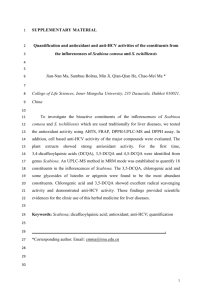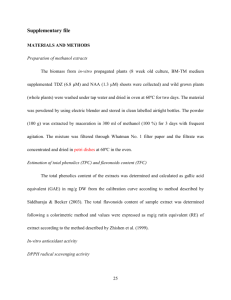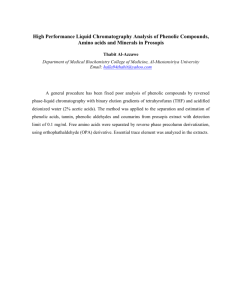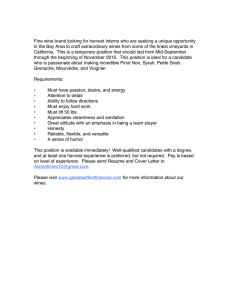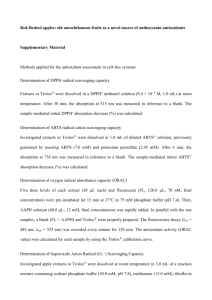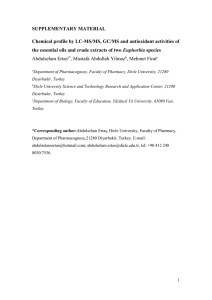Advance Journal of Food Science and Technology 6(3): 344-349, 2014
advertisement
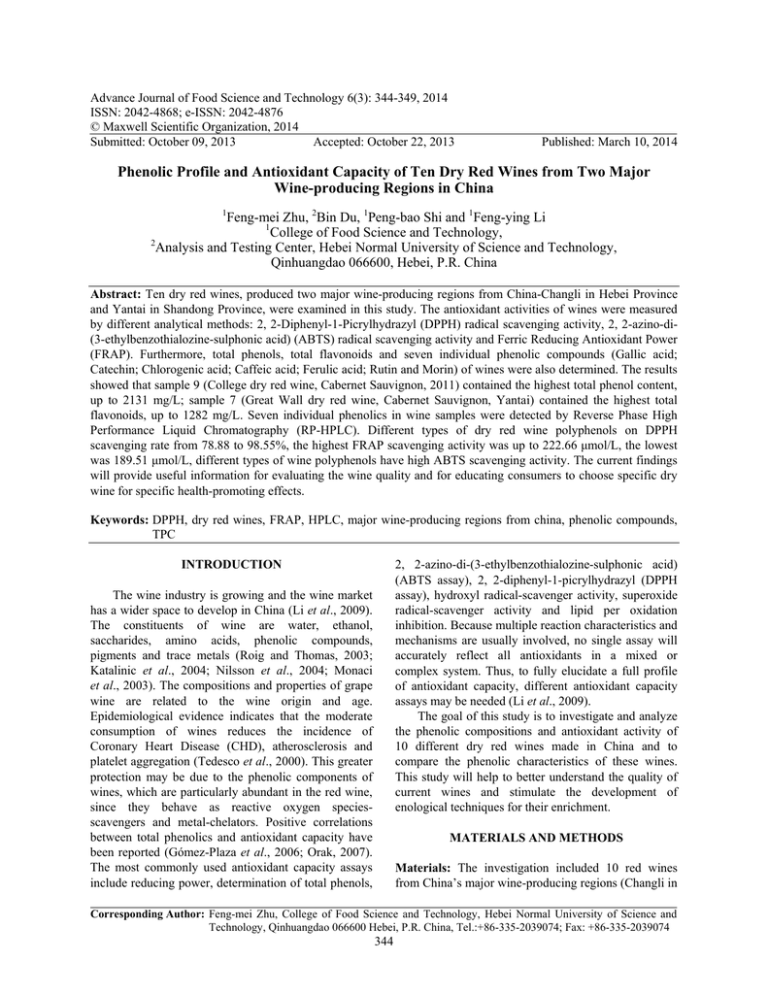
Advance Journal of Food Science and Technology 6(3): 344-349, 2014 ISSN: 2042-4868; e-ISSN: 2042-4876 © Maxwell Scientific Organization, 2014 Submitted: October 09, 2013 Accepted: October 22, 2013 Published: March 10, 2014 Phenolic Profile and Antioxidant Capacity of Ten Dry Red Wines from Two Major Wine-producing Regions in China 1 Feng-mei Zhu, 2Bin Du, 1Peng-bao Shi and 1Feng-ying Li 1 College of Food Science and Technology, 2 Analysis and Testing Center, Hebei Normal University of Science and Technology, Qinhuangdao 066600, Hebei, P.R. China Abstract: Ten dry red wines, produced two major wine-producing regions from China-Changli in Hebei Province and Yantai in Shandong Province, were examined in this study. The antioxidant activities of wines were measured by different analytical methods: 2, 2-Diphenyl-1-Picrylhydrazyl (DPPH) radical scavenging activity, 2, 2-azino-di(3-ethylbenzothialozine-sulphonic acid) (ABTS) radical scavenging activity and Ferric Reducing Antioxidant Power (FRAP). Furthermore, total phenols, total flavonoids and seven individual phenolic compounds (Gallic acid; Catechin; Chlorogenic acid; Caffeic acid; Ferulic acid; Rutin and Morin) of wines were also determined. The results showed that sample 9 (College dry red wine, Cabernet Sauvignon, 2011) contained the highest total phenol content, up to 2131 mg/L; sample 7 (Great Wall dry red wine, Cabernet Sauvignon, Yantai) contained the highest total flavonoids, up to 1282 mg/L. Seven individual phenolics in wine samples were detected by Reverse Phase High Performance Liquid Chromatography (RP-HPLC). Different types of dry red wine polyphenols on DPPH scavenging rate from 78.88 to 98.55%, the highest FRAP scavenging activity was up to 222.66 μmol/L, the lowest was 189.51 μmol/L, different types of wine polyphenols have high ABTS scavenging activity. The current findings will provide useful information for evaluating the wine quality and for educating consumers to choose specific dry wine for specific health-promoting effects. Keywords: DPPH, dry red wines, FRAP, HPLC, major wine-producing regions from china, phenolic compounds, TPC 2, 2-azino-di-(3-ethylbenzothialozine-sulphonic acid) (ABTS assay), 2, 2-diphenyl-1-picrylhydrazyl (DPPH assay), hydroxyl radical-scavenger activity, superoxide radical-scavenger activity and lipid per oxidation inhibition. Because multiple reaction characteristics and mechanisms are usually involved, no single assay will accurately reflect all antioxidants in a mixed or complex system. Thus, to fully elucidate a full profile of antioxidant capacity, different antioxidant capacity assays may be needed (Li et al., 2009). The goal of this study is to investigate and analyze the phenolic compositions and antioxidant activity of 10 different dry red wines made in China and to compare the phenolic characteristics of these wines. This study will help to better understand the quality of current wines and stimulate the development of enological techniques for their enrichment. INTRODUCTION The wine industry is growing and the wine market has a wider space to develop in China (Li et al., 2009). The constituents of wine are water, ethanol, saccharides, amino acids, phenolic compounds, pigments and trace metals (Roig and Thomas, 2003; Katalinic et al., 2004; Nilsson et al., 2004; Monaci et al., 2003). The compositions and properties of grape wine are related to the wine origin and age. Epidemiological evidence indicates that the moderate consumption of wines reduces the incidence of Coronary Heart Disease (CHD), atherosclerosis and platelet aggregation (Tedesco et al., 2000). This greater protection may be due to the phenolic components of wines, which are particularly abundant in the red wine, since they behave as reactive oxygen speciesscavengers and metal-chelators. Positive correlations between total phenolics and antioxidant capacity have been reported (Gómez-Plaza et al., 2006; Orak, 2007). The most commonly used antioxidant capacity assays include reducing power, determination of total phenols, MATERIALS AND METHODS Materials: The investigation included 10 red wines from China’s major wine-producing regions (Changli in Corresponding Author: Feng-mei Zhu, College of Food Science and Technology, Hebei Normal University of Science and Technology, Qinhuangdao 066600 Hebei, P.R. China, Tel.:+86-335-2039074; Fax: +86-335-2039074 344 Adv. J. Food Sci. Technol., 6(3): 344-349, 2014 Table 1: The TPC and TFC in 10 dry red wines Sample No. Region Grape variety 1 Changli Cabernet 2 Yantai Cabernet 3 Changli Cabernet sauvignon 4 Changli Cabernet franc 5 Changli Cabernet sauvignon 6 Changli Cabernet 7 Yantai Cabernet sauvignon 8 Changli Cabernet sauvignon 9 Changli Cabernet sauvignon 10 Changli Zuoyouhong a-e : Bar with no letters in common are significantly different (p<0.05) in cotent Comments TPC (mg/L) TFC (mg/L) Selected 1815±62.77b 802±6.65e 2055±73.56a 1074±12.50c Selected 1845±160.25b 1204±30.53bc 1796±84.55bc 1101±11.13bc Cellaring 3 years 1680±79.00bc 1127±5.85bc 1721±53.50bc 951±7.50d 1642±66.16c 1281±10.53a 2010 1469±28.67d 1137±16.00bc 2011 2149±108.21a 1180±19.50b 2011 1612±70.21c 1092±17.00c the same column; TPC: Total phenolic content; TFC: Total flavonoid Hebei Province and Yantai in Shandong Province). Sample 1, 2, 3, 4, 5, 6 and 7 were purchased at local supermarkets and sample 8, 9 and 10 were acquired from the Experimental Winery at the College of Food Science and Technology, Hebei Normal University of Science and Technology. All information regarding the analyzed samples was summarized in Table 1. FolinCiocalteu reagent was purchased from Beijing Aoboxing Biotechnology Co., Ltd. (Beijing, China). Gallic acid, Catechin, Chlorogenic acid, Caffeic acid, Ferulic acid, Rutin, Morin, 1, 1-Diphenyl-2Picrylhydrazyl (DPPH), 2, 4, 6-tri (2-pyridyl) -striazine (TPTZ) and 2, 2-azino-di(3ethylbenzothialozine-sulphonic acid) (ABTS) were purchased from National Standard Samples Center (Beijing, China). All other reagents were of analytical grade. mixture to 3 mL. The absorbance of the mixture was immediately measured at 510 nm wavelength against a prepared blank using a SHIMADZU UV-2201 spectrophotometer. The flavonoid content was determined by a rutin standard curve and expressed as the mean (milligrams of rutin equivalents per L of wine sample) ±Standard Deviation (S.D.) for three replications. Extraction of phenolics: Phenolics in wine samples was extracted according to a method by Li et al. (2011). The samples were extracted with 100 mL ethyl acetate thrice and then filtered through 0.22 μm organic membranes. Determination of individual phenolics content: For determination of the individual phenolic compounds we used an HPLC Agilent-1200 series instrument equipped with a UV-Vis photodiode array (DAD) detector. After injecting 5 μL of sample, separation was performed in an Agilent-Eclipse XDB C-18 (4.6×150 mm) column. The column temperature was at 30ºC. Two solvents were used for the gradient elution: A- (H 2 O+1% CH 3 COOH) and B- (Methanol). The elution program used was as follows: from 0 to 3 min, 85% B, flow rate was 1.2 mL/min; from 3 to 7 min, 70% B, flow rate was 1.2 mL/min; from 7 to 8 min, 55% B, flow rate was 0.6 mL/min; from 8 to 14 min, 40% B, flow rate was 1.2 mL/min; from 14 to 14.1 min, 85% B, flow rate was 1.2 mL/min. The gradience with five concentrations of mixture standard (Gallic acid, Catechin, Chlorogenic acid, Caffeic acid, Ferulic acid, Rutin and Morin) were set with three replications, seven groups of standard curves of the concentration were made based on the average area of individual compounds and seven polyphenol compounds were qualified by the external standard method. Determination of Total Phenolic Content (TPC): The TPC of samples was determined using the FolinCiocalteu reagent-based colorimetric assay as described by Singleton et al. (1999). Phenolic content was calculated as Gallic Acid Equivalents (GAE) and reported as mg/L wine sample. Briefly, 0.5 mL appropriately diluted sample (or gallic acid standard at 0, 50, 100, 150 or 200 ppm, respectively) was mixed with 0.5 mL of 2 N Folin-Ciocalteu reagent and 7.5 mL deionized water and allowed to stand for 10 min at room temperature; then 3 mL of 20% (w/v) Na 2 CO 3 was added to the reaction mixture and it was placed in a 40°C water bath for 20 min. After the 20 min reaction period, the samples were cooled to room temperature and the absorbance measured at 760 nm (Dong et al., 2013). Determination of Total Flavonoid Content (TFC): The TFC of samples was determined using a modified colorimetric method (Jia et al., 1999). 0.25 mL of 1:10 diluted wine sample was mixed with 1.25 mL of distilled water and subsequently with 0.075 mL of 5% sodium nitrite solution and was allowed to react for 5 min. Then, a 0.15 mL of 10% aluminium chloride was added and allowed to further react for 6 min before 0.5 mL of 1 M sodium hydroxide was added. Distilled water was added to bring the final volume of the DPPH assay: DPPH radical scavenging capacity of samples was evaluated according to the method of Xu and Chang (2007) with slightly modifications. DPPH radicals have an absorption maximum at 515 nm, which disappears with reduction by an antioxidant compound. The DPPH· solution in methanol (6×10-5 M) was prepared daily and 3 mL of this solution was mixed with 100 μL sample solution. The mixture was incubated for 20 min at 37°C in a water bath and then 345 Adv. J. Food Sci. Technol., 6(3): 344-349, 2014 the decrease in absorbance at 515 nm was measured (A s ). A blank sample containing 100 μL of methanol in the DPPH· solution was prepared daily and its absorbance was measured (A B ). The experiment was carried out in triplicate. Radical scavenging activity was calculated using the following formula: % inhibition = [(A s - A B ) /A B ] × 100 where, A B = Absorbance of the blank sample A s = Absorbance of the wine sample Statistical analysis: All results in this study were expressed as mean±S.D. of three replicates. Data in triplicate were analyzed by one-way analysis of variance using SPSS 11.5 software package for Windows (SPSS Inc, USA). % inhibition = [(A s - A B ) /A B ] × 100 where, A B = Absorbance of the blank sample A s = Absorbance of the wine sample RESULTS AND DISCUSSION Ferric Reducing Antioxidant Power (FRAP) assay: This method is based on the reduction, at low pH, of a colorless ferric complex (Fe3+-tripyridyltriazine) to a blue-colored ferrous complex (Fe2+-tripyridyltriazine) by the action of electron-donating antioxidants. The reduction is monitored by measuring the change of absorbance at 593 nm. The working FRAP reagent was prepared daily by mixing 10 volumes of 300 mM acetate buffer, pH 3.6, with 1 volume of 10 mM TPTZ in 40 nm hydrochloric acid and with 1 volume of 20 mM ferric chloride. A standard curve was prepared using various concentrations of FeSO 4 ·7H 2 O. All solutions were used on the day of preparation. One hundred micro L of sample solutions and 300 μL of deionized water were added to 3 mL of freshly prepared FRAP reagent. The reaction mixture was incubated for 30 min at 37°C in a water bath. Then, the absorbance of the samples was measured at 593 nm. A sample blank reading using acetate buffer was also taken. The difference between sample absorbance and blank absorbance was calculated and used to calculate the FARP value. In this study, the reducing capacity of the sample tested was calculated with reference to the reaction signal given by a Fe2+ solution. FRAP values were expressed as mmol Fe2+/g of sample. All measurements were done in triplicate (Xu and Chang, 2007). Total flavonoid content: TFC of 10 dry red wines are presented in Table 1. Among all the wines analyzed, sample 7 had the highest TFC (1281±10.53 mg/L), followed by sample 3, 9, 8, 5, 4, 10, 2, 6 and 1, respectively. There was significant difference (p<0.05) in TFC between sample 7, 9, 10, 6 and 1, respectively. However, significant differences in TFC were not observed among sample 3, 4 and 5, among 2, 8 and 10, respectively (p>0.05). In this study, there was 1.6-fold difference in TFC between the highest and lowest ranked wines, sample 7 and 1. ABTS assay: ABTS was dissolved in deionized water to a 7 mM concentration. ABTS radical cation (ABTS+·) was produced by reaction ABTS solution with 2.45 mM potassium persulfate (final concentration) and allowing the mixture to stand in the dark at room temperature for 12-16 h before use. For the study, the ABTS+· solution was diluted in deionized water or ethanol to an absorbance of 0.7 (±0.02) at 734 nm. An appropriate solvent blank reading was taken (A B ). After the addition of 100 μL of aqueous or ethanolic (according to solubility) sample solutions to 3 mL of ABTS+· solution, the absorbance reading was taken at 30°C 10 min after initial mixing (A s ). All solution was used on the day of preparation and all determinations were carried out in triplicate (Dudonne et al., 2009). The percentage of inhibition of ABTS+· was calculated using the following formula: Fig. 1: High Performance Liquid Chromatography-Diode Array Detection (HPLC-DAD) chromatogram of the individual phenolic compounds mixture standard. Peak identification: (1) gallic acid, (2) catechin, (3) chlorogenic acid, (4) caffeic acid, (5) ferulic acid, (6) rutin and (7) morin Total phenolic content: TPC of 10 dry red wines were measured (Table 1). Sample 9 presented the highest TPC (2149±108.21 mg/L), followed by sample 2, 3, 1, 4, 5, 6, 7, 10 and 8, respectively. The TPC of sample 9, 1, 7 and 8, respectively was significantly different from each other (p<0.05). However, significant differences in TPC were not found among sample 4, 5, 6, 7 and 10, respectively (p>0.05). The results indicated that sample 9 and 2 contained high concentrations of total phenolics. It was well known that the composition of phenolics in wines varied with grape variety, species, seasons, environment and management factors. Both genetic and agronomic or environmental factor play important roles in phenolic composition and concentration. 346 Adv. J. Food Sci. Technol., 6(3): 344-349, 2014 Table 2: Statistical analysis for linearity of the calibration curves of phenolic compounds Phenolic compounds Retention time (min) Linear range (mg/L) Regression equation Gallic acid 2.010 9.5~380 y = 11.2466907x -11.173928 Catechin 4.015 10.6~424 y = 3.16083587x-2.241366 Chlorogenic acid 4.630 10.2~408 y = 6.70393222x-22.538271 Caffeic acid 6.061 10.0~400 y = 18.3117056x-32.742016 Ferulic acid 8.783 10.0~400 y = 0.76399556x-1.8972963 Rutin 9.592 9.8~392 y = 3.82695765x-4.4373345 Morin 10.872 4.9~392 y = 7.2603x-15.383 Table 3: The recovery results of phenolic compounds Phenolic compounds content Phenolic compounds in sample (mg/L) Gallic acid 62.665 Catechin 120.867 Chlorogenic acid 47.216 Caffeic acid 42.641 Ferulic acid 86.777 Rutin 10.670 Morin 7.022 Added content (mg/L) 95 106 102 100 100 98 98 Correlation coefficient 0.99997 0.99997 0.99991 0.99997 0.99995 0.99997 0.99995 The determined content (mg/L) 143.5195 217.3270 151.1540 133.4210 197.1370 101.6434 97.8778 Table 4: The content of gallic acid, catechin, chlorogenic acid, caffeic acid, ferulic acid, rutin and morin in 10 dry red wines Gallic acid Catechin Chlorogenic Caffeic acid Ferulic acid Rutin (mg/L) (mg/L) acid (mg/L) (mg/L) (mg/L) (mg/L) Sample No. 1 62.670 120.87 47.22 42.64 86.78 10.67 2 468.970 582.43 168.27 216.20 501.31 70.41 3 465.890 684.06 256.11 245.24 868.46 128.91 4 57.040 94.33 32.27 38.20 89.53 20.10 5 164.260 258.29 124.84 94.76 350.00 69.99 6 128.540 211.76 99.45 68.41 272.64 61.44 7 342.880 466.82 241.98 159.19 620.55 105.81 8 309.080 590.30 198.08 100.83 614.53 85.82 9 128.700 319.83 131.99 49.47 477.62 59.30 10 96.541 217.44 72.34 27.46 167.27 18.95 Recovery (%) 85.110 91.000 101.900 90.780 110.360 92.830 92.710 Morin (mg/L) 7.02 34.24 61.18 14.24 53.36 24.10 45.54 33.58 18.61 7.15 dry red wines were shown in Table 4. The content of phenolic compounds ranked the samples in descending order, as follows: Ferulic acid>Catechin>Gallic acid>Chlorogenic acid>Caffeic acid>Rutin>Morin. Sample 2, 3, 5, 6, 7, 8 and 9, respectively had the highest Ferulic acid content. Ferulic acid is an abundant phenolic phytochemical found in plant and food. Kikuzaki et al. (2002) suggested that ferulic acid was most effective radical-scavenging activity among the tested phenolic acids. Sample 1, 4 and 10 presented the highest Catechin content: 120.87, 94.33 and 217.44 mg/L, respectively. Analysis of individual phenolics in dry red wines: The High Performance Liquid Chromatography-Diode Array Detection (HPLC-DAD) chromatogram of the individual phenolics mixture standard were shown in Fig. 1. The mixed standard substances were separated at various scanning wavelengths and the wavelength selected can simultaneously determine a variety of phenolics. After analysis and comparison of the spectrograms at each wavelength, it has been found there was no wavelength at which 7 kinds of phenols can be simultaneously determined. This problem can be overcome by using a multiple wavelength scanning program which is capable of monitoring several wavelengths simultaneously, in which 7 phenolics were able to achieve maximum absorption and the baseline was stable, separation and repeatability was good. The statistical analysis for linearity of the calibration curves of phenolic compounds were indicated in Table 2. The correlation coefficient of each phenolic compound was good. As shown in Table 3, the calculated recovery of each phenolic compound ranged from 85.11 to 110.36%, respectively. These results allowed us to conclude that good accuracy was reached in the dry red wine phenolic compounds determination. The content of Gallic acid, Catechin, Chlorogenic acid, Caffeic acid, Ferulic acid, Rutin and Morin in 10 DPPH radical scavenging activity: As a rapid and simple measure of antioxidant activity, the DPPH radical scavenging capacity has been widely used. DPPH is a stable free radical with a characteristic absorption, which decreases significantly on exposure to proton radical scavengers (Sun et al., 2011). The DPPH radical scavenging activity of 10 dry red wines were shown in Table 5 and the values were significantly different. Sample 7 had the highest DPPH radical scavenging activity (98.55±0.52%). The scavenging effect of samples on the DPPH radical decreased in the order of sample 7>sample 1>sample 3>sample 8>sample 10>sample 4>sample 5>sample 347 Adv. J. Food Sci. Technol., 6(3): 344-349, 2014 Table 5: DPPH, FRAP and ABTS scavenging capacity of 10 dry red wines Sample No. DPPH (%) FRAP (μmol/L) ABTS (%) 1 98.33±0.50a 222.09±9.62ab 87.64±3.48abc h cd 2 80.11±0.34 204.97±12.92 91.66±1.31ab b ab 3 97.44±0.38 222.84±9.27 75.57±7.32d 4 91.70±0.46e 202.84±8.58cd 83.62±2.28bcd 5 90.33±0.33f 191.63±11.10d 76.12±3.24d 6 86.44±0.16g 189.51±9.43d 79.59±3.02cd 7 98.55±0.52a 213.45±5.19cd 76.14±4.73d 8 95.22±0.39c 211.63±13.24bc 83.90±8.63bcd 9 78.88±0.44i 229.66±6.17 a 92.54±2.65a d cd 10 94.11±0.42 196.18±4.33 83.90±2.16bcd a-i : Bar with no letters in common are significantly different (p<0.05) in the same column Morin) in 10 dry red wines made from China’s two major wine-producing regions. Our results have found that significant differences in TPC, TFC and individual phenolic compounds can exist among the wines. These dry red wines also showed higher antioxidant activity when evaluation by FRAP, DPPH and ABTS radical scavenging ability assays. This study has shown that the phenolic present in wines has potent antioxidant and that the antioxidant activity in wines is positive correlated with TPC and TFC. These dry red wines from Changli and Yantai may serve as natural antioxidants for human nutrition and health. 6>sample 2>sample 9. It has been reported that the antioxidant activity of many compounds of botanical origin is proportional to their phenolics contents, suggesting a causative relationship between TFC and DPPH radical scavenging activity. Interestingly, sample 7, which exhibited the highest TFC, registered the highest DPPH radical scavenging activity. ACKNOWLEDGMENT This study was financially supported by Institution of Higher Education Science and Technology Research Foundation of Hebei province of China (approved No. 2010247), Science and Technology Research and Development Project Foundation of Hebei province of China (approved No. 12227161) and Startup Foundation for Doctor of Hebei Normal University of Science and Technology (approved No. 2009YB005). FRAP assay: The FRAP assay is often used to measure the antioxidant capacity of foods, beverages and nutritional supplements containing polyphenols. The antioxidant capacities of wine samples using FRAP assay were indicated in Table 5. The wine samples in general exhibited higher antioxidant capacities and the values ranged from 189.51±9.43 μmol/L (sample 6) to 229.66±6.17 μmol/L (sample 9). The results showed that sample 9, which exhibited the highest TPC, registered the highest FRAP activity. This is in agreement with the result obtained by Loots et al. (2006), who suggested that the FRAP of Kei-apple juice correlated well with the polyphenol concentrations. REFERENCES Bao, J., Y. Cai, M. Sun, G. Wang and H. Corke, 2005. Anthocyanins, flavonols and free radical scavenging activity of Chinese bayberry (Myrica rubra) extracts and their color properties and stability. J. Agr. Food Chem., 53(6): 2327-2332. Dong, R., Y.N. Zheng and B.J. Xu, 2013. Phenolic profiles and antioxidant capacities of Chinese unifloral honeys from different botanical and geographical sources. Food Bioprocess. Tech., 6(3): 762-770. Dudonne, S., X. Vitrac, P. Coutiere, M. Woillez and J.M. Merillon, 2009. Comparative study of anoxidant properties and total phenolic content of 30 plant extracts of industrial interest using DPPH, ABTS, FRAP, SOD and ORAC assay. J. Agr. Food Chem., 57(5): 1768-1774. Gómez-Plaza, E., A. Miňano and J.M. López-Roca, 2006. Comparison of chromatic properties, stability and antioxidant capacity of anthocyanin-based aqueous extracts from grape pomace obtained from different vinification methods. Food Chem., 97(1): 87-94. Jia, Z., M. Tang and J. Wu, 1999. The determination of flavonoid contents in mulberry and their scavenging effects on superoxide radicals. Food Chem., 64(4): 555-559. Katalinic, V., M. Milos, D. Modum, I. Music and M. Boban, 2004. Antioxidant effectiveness of selected wines in comparison with (+)-catechin. Food Chem., 86(4): 593-600. ABTS scavenging activity: This ABTS method determines the antioxidant activity of hydrogen donating antioxidants and of chain breaking antioxidants. The ABTS assay is applicable on both lipophillic and hydrophilic compounds (Sasidharan and Menon, 2011). The antioxidant capacities of wine samples using the ABTS assay were shown in Table 5. In present study, the wine samples showed notable A+· cation radical scavenging activity. Sample 9 had the radical scavenging activity highest ABTS+· (92.54±2.65%). The results showed that wine samples with high TPC, also presented a high antioxidant capacity in ABTS and FRAP model. Bao et al. (2005) reported the similar results that the highest ABTS scavenging activity of bayberry was attributed to the presence of higher levels TPC, TFC and anthocyanins. CONCLUSION The present results describe TPC, TFC and 7 individual phenolic compounds (Gallic acid, Catechin, Chlorogenic acid, Caffeic acid, Ferulic acid, Rutin and 348 Adv. J. Food Sci. Technol., 6(3): 344-349, 2014 Kikuzaki, H., M. Hisamoto, K. Hirose, K. Akiyama and H. Taniguchi, 2002. Antioxidant properties of ferulic acid and its related compounds. J. Agr. Food Chem., 50(7): 2161-2168. Li, H., X.Y. Wang, Y. Li, P.H. Li and H. Wang, 2009. Polyphenolic compounds and antioxidant properties of selected China wines. Food Chem., 112(2): 454-460. Li, Z., Q.H. Pan, Z.M. Jin, L. Mu and C.Q. Duan, 2011. Comparison on phenolic compounds in Vitis vinifera cv. Cabernet Sauvignon wines from five wine-growing regions in China. Food Chem., 125(1): 77-83. Loots, D.T., F.H. Van der Westhuizen and J. Jerling, 2006. Polyphenol composition and antioxidant activity of Kei-apple (Dovyallis caffra) juice. J. Agr. Food Chem., 54(4): 1271-1276. Monaci, F., R. Bargagli and S. Focardi, 2003. Element concentrations in Chianti Classico appellation wines. J. Trace. Elem. Med. Bio., 17(suppl 1): 45-50. Nilsson, M., I.F. Duarte, C. Almeida, I. Delgadillo, B.J. Goodfellow, A.M. Gil and G.A. Morris, 2004. High-resolution NMR and diffusion-ordered spectroscopy of port wine. J. Agr. Food Chem., 52(12): 3736-43. Orak, H.H., 2007. Total antioxidant activities, phenolics, anthocyanins, polyphenoloxidase activities of selected red grape cultivars and their correlations. Sci. Hortic., 111(3): 235-241. Roig, B. and O. Thomas, 2003. UV monitoring of sugars during wine making. Carbohyd. Res., 338(1): 79-83. Sasidharan, I. and A.N. Menon, 2011. Effects of temperature and solvent on antioxidant properties of curry leaf (Murraya koenigii L.). J. Food Sci. Tech., 48(3): 366-370. Singleton, V.L., R. Orthofer and R.M. LamuelaRaventos, 1999. Anlysis of total phenols and other oxidation substrates and antioxidants by mean of Folin-Ciocalteu reagent. Method Enzymol., 299: 152-178. Sun, Q., H.X. Shen and Y.K. Luo, 2011. Antioxidant activity of hydrolysates and peptide fractions derived from porcine hemoglobin. J. Food Sci. Tech., 48(1): 53-60. Tedesco, I., M. Russo, P. Russo, G. Iacomino, G.L. Russo, A. Carraturo, C. Faruolo, L. Moio and R. Palumbo, 2000. Antioxidant effect of red wine polyphenols on red blood cells. J. Nutr. Biochem., 11(2): 114-119. Xu, B.J. and S.K.C. Chang, 2007. A comprartive study on phenolic profiles and antioxidant activities of legumes as affected by extraction solvents. J. Food Sci., 72(2): S159-S166. 349

